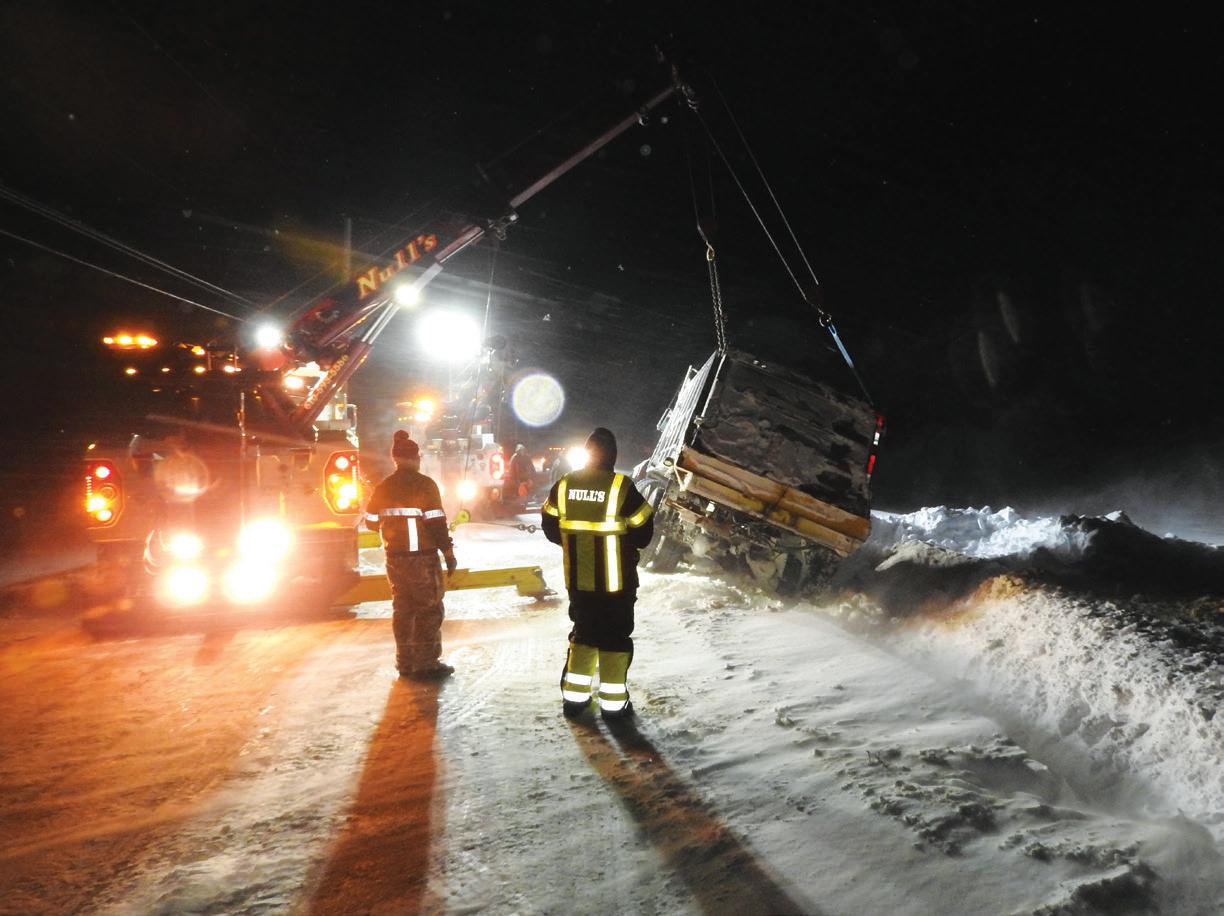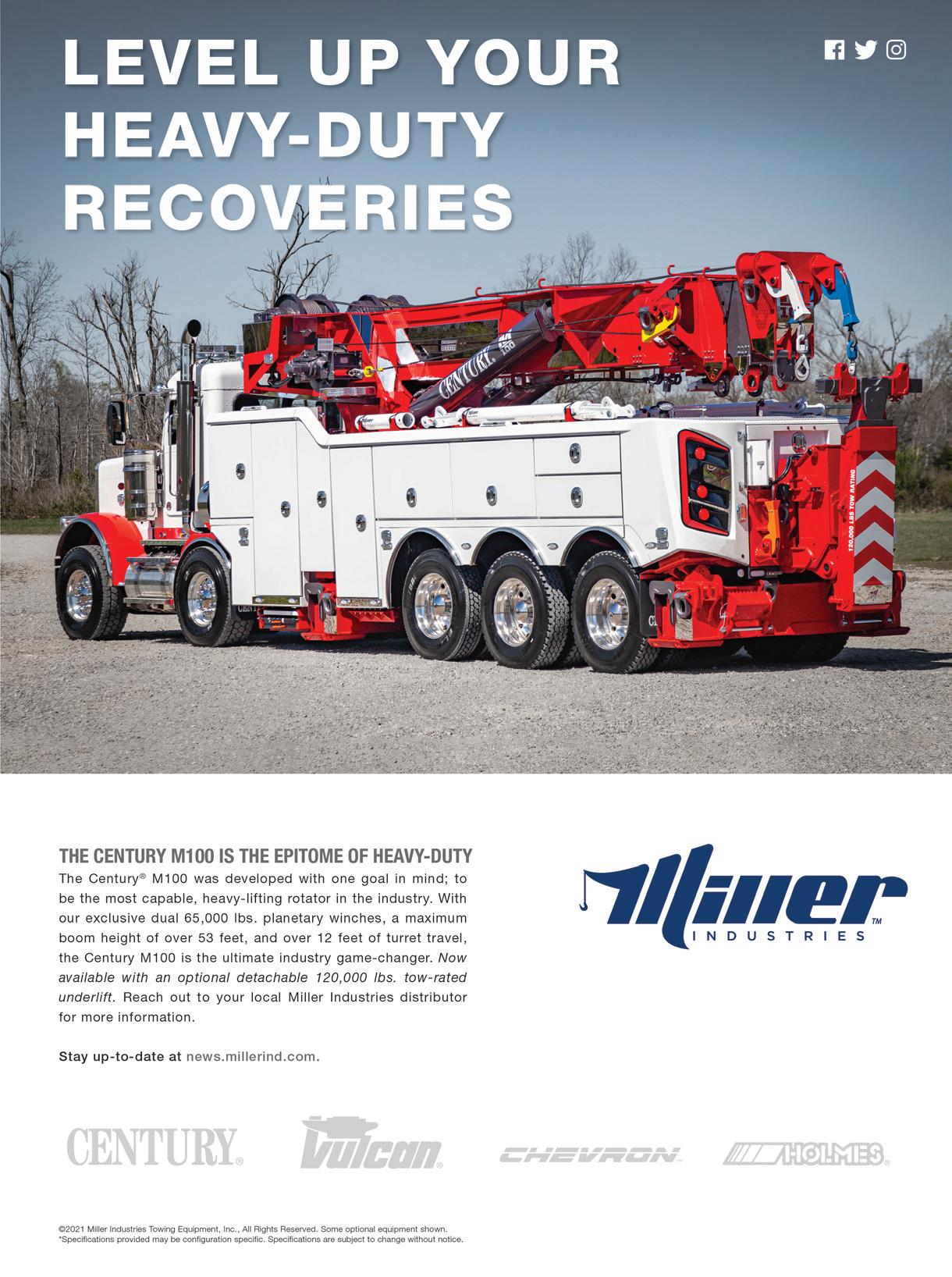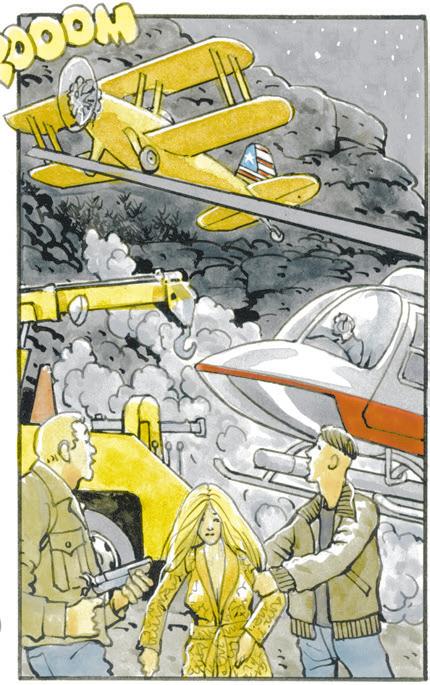
9 minute read
Lighting
Light towers are a critical component to night-time recovery work.
Let There Be Light!
By David Cotsmire
Note: David Cotsmire is VP of Marketing and Customer Service for Will-Burt Night Scan HDT light towers. Will-Burt is known worldwide for its light tower products. Light towers are the ultimate tools when it comes to lighting up an accident scene or job site. The advent of the LED light allowed light tower manufacturers the ability to offer what was once only able to be installed on a fire truck with a full-size generator to be customized for the specific needs of the tow professional who works every day and night. A misconception about light towers is that they are too big or expensive for anything other than the outfit that has heavy wreckers and rotators. Thanks to the lightweight and compact design of folding light towers they can be used on any vehicle that has a roof! The roof surface on a standard rollback has more than enough area for a lightweight folding light tower.
What benefits does a Night Scan HDT deliver? Simply put, it provides more light from a higher height. Break it down a bit further - light from a higher point allows the illumination to be focused and spread over a wider area. This gives you more coverage and provides a safer work site. Also, the light from this higher vantage will not blind you. The light is created from above like the sun. This is also important if you are working a traffic scene, it will not blind oncoming traffic. A light tower also gives you the ability to rotate and tilt the lights, so you can focus on the location that you need regardless of the position of the truck or boom. Higher end light towers offer the ability to control two banks of light separately so that you can cast the light a full 360°.
Light towers are available in two basic configurations: folding, which are designed to be installed on a flat surface and vertical which requires less surface area to install and are typically available in higher heights. Lights typically come in pairs to balance the load and disbursement of light.
A light tower gives you the ability to take on nearly any job at night. We have seen examples of house demolitions, moving heavy equipment and providing emergency lighting for municipal emergencies. A light tower, which is always with the vehicle, frees an operator from relying on the fire ◀

Will-Burt light tower positioned to shine on the recovery not highway traffic. department or a second crew with a tow behind light trailer both of which can cost extra money or be unreliable. Let’s face it, you are always the last to leave the scene.
The light towers’ safety benefits are obvious. You can see to perform the job in near daylight conditions AND most importantly, oncoming traffic will be able to see you.

Light from a higher point
allows the illumination to be focused and
Not so obvious are the various ways you can make more money. Some states allow the use of a light tower to be charged as auxiliary equipment necessary for the job. We have heard that some charge up to $250 / hour, but many are more in the $250-$500 range / job. Another way is to take on jobs that are more easily done at night when there is less traffic on the road. Moving heavy equipment or demolition jobs are common.
Light towers can be installed as part of the original truck build or as a retrofit. The installation is straight forward, and most shops can install a tower in a day or less - there is a good chance you can install it yourself if you are mechanically inclined. A light tower is an investment that will pay off by giving you safer working conditions, enabling you to do the job more efficiently and enabling you to make more money.


You know those TV reporters who stand in the wind and rain talking about the hurricane hitting land. Imagine if their union negotiated their hazard pay based on the established category of the hurricane. Those out there during a Category Five hurricane would be earning the optimal pay. Well, the Recovery Classification Standard presented here was created with the categorization of hurricanes in mind as a general model. Towers, like those reporters, have no choice but to work outdoors in all conditions. What are the elements that classify the severity of a storm? Well, what are the elements that classify the level of risk and challenge of a recovery, is the question we answer in this presentation.

Classifying RECOVERY Work
By Steve Calitri and John Borowski
Tow work, regulated or not, is easily defined, and parameters one uses to set tow rates are relatively simple. This is not the case with Recovery work. Not only does Recovery take more training and skill than towing a vehicle, but the risks associated with the conditions of terrain, weather, and other hazards grow more acute. A tow involves a vehicle upright on its wheels on a road or pavement. A Recovery involves a vehicle or heavy object not on its wheels, not upright, perhaps in a ditch, down a slope or cliff, in a river or lake, leaning precariously on a rock or tree, or caught in countless other predicaments. The work is inherently dangerous. Add inclement weather and it is more dangerous.
There has been a great disparity of rates among towers all over the country for Recovery work. A disparity in tow work will be in two digits; in Recovery work the disparity will be in four or five digits. In these instances, a tower may be more or less accurate about the costs entailed for a job. The attitude on billing and making a profit may be different from one tower to the next. What amount of money one tower figures he needs to make may be far from the amount another tower figures, all for various reasons.
There has never been a standard guideline characterizing recovery work that would support an itemized invoice. There are methods of how to price a job; per truck, per hour or price per pound. Some towers have created a flat fee for different kinds of jobs as a minimum charge. Still, there has never been a standard way of defining a job as it affects the charge, taking in the most critical aspects of the work.
The Standard Classifications sheet being proposed here takes in critical elements that should be considered in the fee for any recovery job. You will see it even will apply to a basic tow. Many towers do, and many do not, take into consideration the factors listed in each Class, as detailed here. This sheet offers a standard way at defining a job. It does not tell the tow business owner what rate to charge. It tells he or she what the percentage of surcharge is warranted given the class of the recovery. This sheet offers guidance to those who may need it, and support to the most professionally detailed invoices. If you have a detailed, itemized invoice, and you’ve surcharged for things like inclement weather, difficult terrain, hazmat, what-haveyou, this Recovery Classification Sheet may be attached, showing support for these surcharges. With

Inclined terrain would categorize this recovery as Class 3. this sheet attached, it isn’t only your company saying you are justified for upcharging, it’s the industry standard, sanctioned by industry-wide organizations.
A few of the items bear discussion.
Under Class 1, note the item: Law Enforcement Traffic Control Present. If there is no police officer or trooper on the scene to help protect the tow operator from passing traffic, even the simplest breakdown could be a Class 2 tow or recovery. This standard states you are warranted to increase your charge by 50%. This item also sets the framework for using your own traffic-control vehicle and operator and charging for it.
If a vehicle is broken down on a road inclined 30 degrees or more, it poses greater difficulty and risk. This makes it a Class 2 incident, whether it is being just towed or it needs to be recovered. It too warrants a surcharge of 50% on the total amount.
Most of the items listed need little or no explanation to the experienced tow operator. Two more items may need explanation to some.
First: Nights, Holidays, Weekends. Most service businesses will not come out on these days and may not be at all available. Some will come out in an emergency. The customer will be charged for it. If a tow boss values the mental health and spirits of his or her operators, he will value the time they need to spend with family, or any kind of time off. Towers who work these days should be paid a premium wage, and to do so the business must charge extra.
The last item to point out is listed in Class 4: Trapped or pinned victims or bodies. Work involving trapped victims calls for courage and skill under pressure. Liabilities come into play in such circumstances, and the operator is doing more than just recovery on a machine. Many modest and honest towers would not think to surcharge for this, but the standard we present her states it is warranted to surcharge the total by as much as 200%.
Read over the classifications list shown here. We encourage you to email us your comments. Email scalitri@ towman.com and Johnborowski@comcast.net.
Standard Tow & Recovery Job Classifications
(based on conditions at the scene and levels of risk and hazards to operators)
Class 1 standard rates apply • Tow or Recovery with usual risks • Level ground • Fair to clear weather • Law Enforcement Traffic control present Class 2 50% increase of rates is warranted • Inclement weather: rain, fog, snow, high winds, extreme cold or heat • Nights / Holidays / Weekends • No Law Enforcement Traffic control present • Incident on an elevated bridge • Vehicle is down on a plane inclined or declined 30 degrees or more • Vehicle is resting in precarious position • Flammable (high flash point) • Illicit discharge (fluid spill) Class 3 100% increase of rates is warranted • In water (lakes, ponds, rivers, ocean) • Inclined or declined embankment • Utility hazards present (gas, electric, propane, etc.) Class 4 200% increase of rates is warranted • Explosives • Hazmat • Chemicals • Flammable (low flash point) • Trapped or pinned victims or bodies Class 5 300% increase of rates is warranted • Nuclear or Radioactive
Only one listed condition is required to define the incident classification. Example of rate change from an invoice starting at $5000.00 and increasing with each incident class. Four-hour minimum charge for a Recovery is standard.

Note: This Standard may be applied to any towing & recovery job with just fees. This Classification method does not and cannot characterize whether a company’s basic tow and recovery rates are fair and just, high or low. An individual tow-business owner sets rates upon many factors: the cost of equipment, providing emergency service, dispatch, and fielding trained operators being but a few of the many cost factors involved. One company’s basic rates may be justifiably different than another company’s rates.









